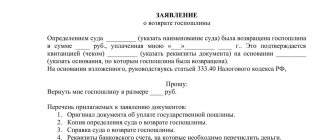According to Rosstat, more than half of all marriages are dissolved. And the number of divorces still remains at a high level - registry offices register about 600,000 divorces annually. At the same time, the number of registered marriages is decreasing; couples increasingly prefer to live without the burden of official registration. But if such a relationship breaks down, the ex-husband and wife will not have any rights or responsibilities. The Family Code regulates only relations in a registered marriage , including situations arising during the division of property of spouses.
How should property be divided?
Equally according to the law
Spouses can divide property both during marriage and after its dissolution. At the same time, the division of property in 2021 does not have to be carried out in court. Spouses can decide among themselves who will keep this or that property or in what shares to divide what they acquired during the marriage, and enter into a notarial agreement on the division of property. In an agreement on the division of property, the spouses consolidate the agreements reached. If there is no agreement between the husband and wife on the issue of division of property, then the division of property is carried out in court. The court will decide what property should be recognized as the common property of the spouses, in what shares such property should be divided, and to whom what property should be transferred.
According to current legislation, the property that was acquired or acquired by the spouses at the expense of common income from compensated transactions during the marriage is subject to division. Such property is the common property of the spouses or, in other words, jointly acquired property. In this case, it does not matter which of the spouses such property is registered with or which of the spouses worked and earned more. Exceptions to this rule are written below. Common property can be movable and immovable property, deposits and cash, shares, shares in the authorized capital of commercial companies, that is, everything that was purchased was credited to a current account in the name of any of the spouses.
Property received during marriage through gratuitous transactions - as a gift, through privatization, as well as by inheritance - is recognized as the property of the spouse to whom such property was transferred.
Property can be divided before and after divorce. To do this, you need to go to court or draw up a notarized agreement on the division of property.
As a general rule, all property is divided equally. In practice, this means that each spouse is recognized as having 1/2 shares in the property right. In this case, indivisible property can be transferred to one of the spouses with the condition that monetary compensation is paid to the second spouse.
An agreement on the division of property can determine a different ratio of shares. Not necessarily 1/2. If the division of property occurs in court, then the court may award one of the spouses more than half of the property, for example, if a minor child remains living with one of the spouses or if the second spouse did not have earnings during the marriage for an unjustified reason. But the wife’s lack of income, if she is caring for a small child or running a household, cannot reduce her share in the common property.
When it comes to the division of property, we most often mean the division of things, cars, real estate. But it is important to know that in 2021, debts acquired by spouses during marriage are also subject to division. For example, if a husband and wife wanted to buy a car and took out a loan to buy a car, then when dividing the car, each spouse will have the obligation to repay half of the debt. Before going to court to divide property, it is always important to find out what loans were issued during the marriage in order to develop the correct tactics for conducting the case.
Not all debts that arose during the marriage can be recognized as common. To recognize debts as common, it is necessary to prove that they arose in the interests of the family and with the consent of both spouses. This rule allows you to protect the interests of the more conscientious spouse and not place the burden of debts carelessly taken on by the second spouse onto his shoulders.
Both movable and immovable property and funds, as well as debts acquired during marriage, are subject to division.
Is it necessary to divide property?
Situations are quite common when the purchase is made in the name of one of the spouses. If there is peace and harmony in the family, then it does not matter. But when a couple breaks up, the risks of such a design immediately become noticeable.
- The spouse in whose name the property is registered can sell it. In this case there will be nothing to share. Theoretically, it is possible to divide the proceeds, but it is much more difficult to collect them if the spouse does not have official income or other property.
- If the spouse to whom the property is registered has debts, then creditors can collect the debt from such property.
- And finally, the one who is recorded as the owner according to the documents can rent out the item . In this case, the second spouse will not only lose part of the income, but will also suffer a loss if the leased common property is damaged, worn out, spoiled or lost.
- The following situation is also possible: in order to sell jointly acquired real estate, it is necessary to obtain a notarized consent of the ex-spouse for the sale . If many years have passed since the divorce and the former spouses have separated or simply do not communicate, then it will be quite difficult to obtain such consent. The deal may be delayed or may not take place at all.
To avoid such situations and not depend on each other’s good or bad will, it is advisable to divide property. This will bring certainty to property relations and eliminate the need to sort things out in the future or suffer property losses.
If there is no agreement on how to divide property, then it makes sense to contact experienced practicing lawyers. Often disputes arise and persist due to a misunderstanding of the law and one’s rights to property. If a lawyer gets involved in the case, the dispute can be settled amicably after both spouses are explained their rights and obligations and possible acceptable options for dividing property in 2021 are suggested. If the case goes to court, then the participation of a lawyer is already necessary, because after the decision is made it will not be possible to go to court again to divide the property. And if an unjust division happens, then nothing can be changed.
The concept of joint property of spouses
Before understanding the types of regime for joint property of spouses, it is necessary to understand what joint property of spouses is.
In accordance with Part 1 of Art. 34 of the RF IC, property acquired by them during marriage is recognized as joint property of spouses.
What kind of property acquired during marriage does the legislator recognize as joint (part 2 of article 34 of the RF IC)?
- any income (from labor, intellectual and entrepreneurial activities)
- pensions, benefits and other payments that do not have a specific purpose (for example, maternity capital is a targeted payment and is not subject to division);
- movable and immovable things;
- securities, shares, shares in the capital of credit institutions and other commercial organizations;
- other property acquired during marriage, regardless of which spouse it was acquired in the name of and/or which spouse contributed funds.
Rights of spouses
When resolving any legal issue, and division of property is no exception, you should start by studying the documents and understanding your rights in the current situation. Current legislation recognizes the following rights for spouses:
- all property acquired jointly during marriage, as well as debts, are subject to division in equal shares, unless the marriage contract provides for a different ratio of shares.
- the share of one of the spouses can be increased taking into account his interests or the interests of the children, for example, if a minor child remains living with one of the spouses, if the spouse has an illness, if the second spouse did not have earnings for an unjustifiable reason, etc.
- A non-working spouse's share cannot be reduced if she did not work because she was busy caring for children or running a household.
- a spouse has the right to count on monetary compensation if the second spouse still has common indivisible property, for example, a car.
Each division of property has its own characteristics, but these basic rules will help you navigate the initial stage and understand what you can count on if the case goes to court.
Procedure for drawing up an application
The claim is submitted to the court office. There are no special requirements for filing a claim for division of property. The courts are guided by Art. 131 – 132 Code of Civil Procedure of the Russian Federation. Please indicate the name of the court first. Then personal data and information about the defendant.
Describe the circumstances of the case: when the marriage was concluded and dissolved, whether there are children, with whom they live. Next, list the disputed property indicating its price. If agreements were signed, please attach them too. The next part is the requirements themselves and their rationale. At the end there is a list of attached documents and evidence, then a signature and date.
Property that is divisible and not divisible
As a general rule, everything acquired by spouses during marriage from common income through compensated transactions, as well as the income itself and funds, are jointly acquired property. Such property becomes the common property of the spouses, even if it is registered in the name of one of them. But it happens that one of the spouses gets a car or an apartment, or a plot of land by inheritance or under a gift agreement. This is personal property and cannot be divided. In order to determine which property will be divided and which will not, you need to understand:
- under a compensation agreement, this property came into ownership or free of charge.
- on income received during marriage or on premarital funds.
- purchased with funds received from the sale of personal property (received as a gift, inheritance, belonging to the spouse before marriage), or from common income.
- purchased for children or not.
- whether it is a luxury item or not.
Property that belonged to each spouse before marriage is not divided. Property that, although acquired during marriage, was purchased for children is also not divided. For example, if a couple bought a computer for a child to do schoolwork or sports equipment, then this is the child’s property; parents cannot lay claim to such property. Items for personal use are also the personal property of the spouse for whom they were purchased, except for jewelry and luxury items.
Despite such a clear rule, in practice spouses may encounter situations from which a way out can only be found by knowing the judicial practice. Not all issues are regulated by the Family Code of the Russian Federation. Courts are still developing approaches to solving problems that are not expressly described in the law.
Who should pay for the division of property?
PlaintiffDefendant
For example,
an apartment purchased under a gratuitous agreement becomes the personal property of the spouse and is not subject to division .
But if such an apartment was significantly improved at the expense of the joint income of the spouses - repaired, redesigned, reconstructed - then it can be recognized as common property. A plot of land provided free of charge by order or decree of the municipality also belongs to the common property of the spouses. To understand the correct prospects for the division of property, it is necessary to take into account not only the general rules, but also the nuances enshrined in judicial practice. The variety of property disputes has created a variety of options for resolving such disputes.
How to divide a car after a divorce
A car is an indivisible property, so in most cases it is transferred into the ownership of one of the spouses. When transferring a car, the court takes into account which spouse uses the car more often, who needs it for work, who has a driver's license and is interested in using the car. The court awards monetary compensation to the second spouse in proportion to the share in the right to the car. If the shares are considered equal, then the compensation will be half the cost of the car. To determine the value of the car, the court orders an examination, which determines the fair market value of the property.
Inherited property
Property received by one of the spouses by inheritance is the property of that spouse. This rule is enshrined in Article 36 of the Family Code. The second spouse has no right to claim such property. But just as there are exceptions to every rule, inherited property can be recognized by the court as the common property of the spouses. This is possible if the inheritance received in property was improved at the expense of the common income of the husband and wife, at the expense of the property of each of the spouses or the labor of one of the spouses. For example, a wife inherited a country house. Both spouses worked and used their earnings to renovate the house, adding a veranda and a second floor to it. In this case, the court may recognize the house as the common property of the spouses.
Debts and mortgages of spouses
As mentioned above, when dividing property, one must remember that all debts acquired during the marriage will have to be divided, including real estate taken on a mortgage.
The division of debts is always a very painful topic; often one of the spouses may not know anything that the second spouse has taken out a loan. To protect against abuse, the Family Code establishes a rule according to which only those debts that arose with the consent of the second spouse and were spent on the needs of the family are recognized as common debts that are subject to division. According to Russian law, in order to take out a consumer loan or a regular loan, the consent of the second spouse is not required; banks require such consent only when concluding a mortgage loan. Therefore, during the divorce process, it may turn out that one of the spouses has accumulated loans, which will now have to be divided equally. Dividing debts does not mean that each spouse will be ordered to pay half of the loan. In practice, everything happens differently. If the loan, including a mortgage, was issued to one spouse, then he will continue to repay the loan. After the shares in the property are recognized as equal, the spouse paying the loan has the right to recover half of the payments from the second spouse. To do this, you should apply to the court with a request to recognize the loan debt as common property. If you do not make such a claim, you will lose the opportunity to recover half of the payments from your ex-spouse.
To divide loans issued during a marriage, including mortgages, you need to file a lawsuit to recognize the loan debt as the common property of the spouses and determine the spouses’ shares in the debt obligation.
Personal property
When it comes to dividing property, it is necessary to immediately determine which property should be excluded from the division. It is considered the personal property of each spouse and is not subject to division:
- property that belonged to each spouse before marriage.
- property received by one of the spouses during marriage as a gift, passed on by inheritance or through other gratuitous transactions.
- things for personal use (clothes, shoes and others), but these do not include jewelry and other luxury items, although acquired during the marriage at the expense of the spouses’ common funds.
- exclusive right to the result of intellectual activity, for example, a book, painting, scientific work, etc.
It is more difficult to protect your property from division if personal property was sold during the marriage and a new item was purchased with the proceeds. There is a risk that such an item will be recognized as common property. According to the law, the money received by a spouse from the sale of personal property belongs only to him. This is his personal property. But difficulties arise if it is not possible to distinguish this money from the general family budget.
If personal property is sold during a marriage—whether it was acquired before the marriage or received as a gift or inheritance during the marriage—then keep the proceeds in a separate account . This will allow, in the event of a dispute, to distinguish between jointly acquired property and your personal funds.
Business section
When deciding on the division of a business, we are talking about the division of real and movable property that is used for business purposes, as well as the division of shares and shares in the authorized capital of commercial companies.
When dividing a business, it is necessary to take into account many nuances and in each case develop an individual line of defense. There are several options for resolving a property dispute:
- shares in the authorized capital and shares can be divided like any other property.
- a spouse who is a member of the company can leave the company, receive the actual value of his share and divide it by agreement with the second spouse.
- the business owner spouse can provide the second spouse with compensation in accordance with the share due to him - cash or real estate.
- a share in the authorized capital or shares can be sold and the proceeds divided.
Often, one of the spouses runs the business, so when dividing property, they actively resist giving up anything related to the business. Such cases are the most complex and require the participation of a lawyer in order to understand the intricacies of property relations and make a fair division.
| Shares | Doesn't share |
| Movable property (vehicles, etc.) | Received as an inheritance or as a gift |
| Real estate (house, apartment, room, garage, cottage and other buildings) | Personal belongings and hygiene items. Property necessary for further activities (including cars) |
| Electronics and household appliances | Rights to the results of activities and creativity |
| Income, savings and debt obligations | Property acquired before marriage or after its dissolution |
| Securities, deposits and investment units | Payments from personal insurance |
| Luxury items (jewelry, paintings, etc.) | Any property of children |
Additional documents for special cases
When deciding to prepare documents for the court, it is necessary to take into account the specific circumstances of the case. First of all, we are talking about several key factors, the most common of which should be considered separately.
Property type
When dividing real estate (apartments, private cottages, estates and houses, rooms and other residential premises, plots of land, commercial and outbuildings, garages, etc.), the following additional documents are provided:
- an extract from the Unified State Register of Real Estate on the ownership of the object, other title documents;
- technical or cadastral passport and other similar documentation;
- payment documents confirming payment for the acquisition of property;
- independent assessment of the market value of a real estate property;
- for housing - an extract from the house register about registered residents and the presence/absence of debt on utility bills.
When dividing a vehicle, the technical passport, documents on the purchase and registration of the car, expert opinions on the cost of the car and other similar documentation are considered as additional documents. If other types of property need to be divided, the title documents for the property become key.
When spouses live separately
Often spouses separate before the marriage is officially dissolved. This must be taken into account by the court when making a decision. The fact is that property acquired during separation is personal and is not taken into account when dividing property. The only condition is mandatory confirmation of the fact of separation of the spouses, documentary or witness.
If you have children
Property registered in the name of children is not subject to division upon divorce. There are simply no exceptions to this fundamental rule. Moreover, it does not matter whether we are talking about real estate, movable property or funds - cash or placed on accounts opened in the name of the child. Personal property of children includes any gifts addressed to them. It is also necessary to remember that the spouse with whom the children remain has the right to claim more favorable conditions when dividing property.
Married or after divorce
As noted above, the law allows for the division of property at any stage of marriage. Before its conclusion or after official registration, a marriage contract is drawn up, and after a divorce, a settlement agreement is drawn up. The list of required documents for all of the above situations differs slightly (the presence of a certificate of marriage or divorce). The main requirement is notarization of the marriage contract or settlement agreement.
Voluntarily or through court
Divorce proceedings accompanied by the division of marital property are always painful and require patience, time and financial expenses for a lawyer.
Each couple decides for themselves how far they can go in dividing property and whether it is worth going to court or can be resolved at the negotiating table. The law contains rules both in the case of judicial division of property and in the case of a peaceful settlement of the dispute.
Ex-spouses can divide property as follows:
- conclude an agreement on the division of property and specify in it who is to transfer what property; such an agreement is certified by a notary.
- file a claim in court for the division of jointly acquired property and determination of shares in this property.
- before the divorce, enter into a prenuptial agreement.
No court makes people closer and happier, but it can help quickly, effectively and fairly defend property rights. The main condition here is to correctly state and substantiate claims and build tactics in court . In case of an error a second time, it will no longer be possible to go to court; the decision taken and entered into force will be final.
By mutual agreement
Spouses can divide common property by written agreement, without necessarily bringing the matter to court. Such an agreement must be certified by a notary. In practice, notaries themselves prepare an agreement on the division of property; the spouses only need to reach agreement and explain to the notary how the property will be divided. To ensure that your rights are not violated by the separation agreement, contact a practicing lawyer before signing such an agreement. This way you will be sure that you will receive a fair share of the jointly acquired property.
Judicially
In the event of a dispute about who is entitled to what part of the property and what is considered jointly acquired property and what is personal, the division of property is carried out in court.
To do this, you need to collect documents on the property, prepare a statement of claim and go to court. More information about how to go to court is written below in the next section.
When dividing the common property of the spouses, the court determines what property is to be transferred to each of the spouses, in what shares the property should be divided - in equal shares or to deviate from the equality of shares and transfer more than half of the property to one of the spouses. In the event that one of the spouses is transferred property whose value exceeds his/her share, the other spouse is awarded monetary compensation.
Often, even before the official divorce, spouses actually separate and do not maintain relations. If during this period any of the spouses acquires property, the court may recognize such property as personal property and refuse to divide it.
Is a prenuptial agreement a reason for mistrust?
Not really
Even if a dispute over the division of property is referred to the court, there are still ways to resolve the issue peacefully. Before a court decision is made, spouses may enter into an agreement on the division of jointly acquired property. In this case, the agreement will be approved by the court and will have the force of a court decision.
Through a marriage contract
During marriage, spouses can enter into a prenuptial agreement. In this agreement, you can determine any shares in the right to property, transfer the property in whole or in part to one of the spouses. A prenuptial agreement can determine which property will be transferred to which spouse in the event of divorce. Such an agreement, like an agreement on the division of property, is certified by a notary. Without such a certificate it is not valid.
A marriage contract can be concluded both in relation to the existing and in relation to the future property of the spouses.
If the need for division of property arose after the divorce, and a marriage contract was not concluded, then instead of a marriage contract, an agreement on the division of common property acquired during the marriage is concluded.
How the decision is made
The court considers and makes a decision only on the stated requirements. That is, if the plaintiff declares that, for example, a car and an apartment are recognized as common property, but does not indicate in what shares to divide the property and to which of the spouses to transfer the car, then the court will not determine the shares and decide who to transfer the car to and from whom to recover compensation.
The court does not collect evidence for the plaintiff and defendant and does not consult the participants in the court , but weighs, considers the voiced arguments and the evidence presented, after which it retires to the deliberation room and makes a decision.
That is why it is important, when filing a claim and when considering a case, to clearly and fully formulate all your requirements and collect comprehensive evidence, otherwise a judicial act will not solve the property problem.
Agreement on division of marital property
Drawing up a notarial agreement between those divorcing can significantly facilitate the process of dividing property. It helps determine the shares of the wife and husband in jointly acquired property on mutually beneficial terms.
Important!
It is necessary to have the contract certified by a notary. Without this, the document has no legal force. Moreover, in such a document all issues related to the property must be resolved, otherwise the notary will not certify this document and it will not have sufficient significance during the process.
After the spouses have discussed the details of the division of property, they need to visit a notary with the following package of documents:
— purchase and sale agreements;
— all sales and cash receipts;
— documents confirming ownership;
— certificates of registration of property rights;
— PTS (if we are talking about a car) and other documents;
- passports of husband and wife.
The cost of notary services for concluding a voluntary agreement on the division of property is 0.5% of the valued property + 5 thousand rubles. with the right to transfer ownership or 10 thousand rubles. without the right to transfer ownership.
You should not prepare the agreement document yourself. It is drawn up by a notary on a special form; the spouses are only required to present their wishes regarding the subsequent ownership of the property.
Features of the section if you have children
If the family has a minor child or children, this may affect the ratio of the spouses’ shares when dividing property. The parent with whom the child remains to live is forced to bear additional costs for the maintenance and upbringing of the child; the parent and child require more living space than one person. If a child has illnesses, then there is a need for an increased level of comfort, special nutrition, and the parent incurs additional costs for treatment and maintenance of the child. The court may take these circumstances into account and, during division, increase the share of the parent with whom the minor child remains to live.
When buying a home using maternity capital, the child will claim a share in the home itself - an apartment, a house. Such housing will be shared between spouses and children. In this case, the children receive part of the apartment paid for with maternal capital.
Maternity capital during divorce
Issuing maternity capital is one of the methods of state support for families with children. Maternity capital is provided in the form of a personalized certificate in the name of the mother who gave birth to or adopted a second or next child.
Only the recipient can dispose of these funds. Maternity capital can be used only for the intended purpose provided for by law. Money is allowed to be spent on:
- improvement of living conditions;
- child's education;
- increasing the size of the funded pension;
- payment of a monthly allowance in the amount of the subsistence minimum for children established in the region of residence.
One way or another, maternity capital appears in the family budget. Let's figure out how to divide it in the event of divorce.
How is it divided and who gets it?
In accordance with the norms of family law, not only movable and immovable property, but also money is subject to division between spouses. An exception to this rule is targeted funds - benefits and various government subsidies.
Since maternity capital is a targeted monetary payment, it is not subject to division in the event of a divorce. This is not joint property. Matkapital goes to the person in whose name it is issued. As a rule, this is a woman, but sometimes the father of the children can count on maternal capital.
Does the husband have the right to receive it if the children remain with the father?
So, divorce and division of property cannot be the basis for transferring rights to maternal capital to the father of the children. However, in some cases the mother loses the right to receive payment.
Such situations include:
- commission of a crime by a mother against her own child;
- death of mother;
- recognition of the mother as dead or missing;
- termination of adoption of a child by the mother;
- deprivation of mother's parental rights.
In addition, a father can receive maternity capital if he independently raises two or more children (born or adopted).
With a mortgage
When purchasing housing with a mortgage using maternity capital, exactly the same rules apply as when purchasing an apartment without using credit funds. The main rule is equality of shares for all family members, including children.
The process of dividing such property has two features:
- The mortgage payment obligation between divorcing spouses is divided in half, although each of them may have a smaller share. For example, the share of each family member if there are two children will be 1/4.
- Before the loan is repaid, the sale of the mortgaged apartment may not take place. Such transactions are carried out by the bank, and the price of real estate is set below the market price. The proceeds are primarily used to pay off the debt. For an independent sale, the consent of the bank as the mortgagee will be required.
Since the apartment partly belongs to children, its sale will require the consent of the guardianship and trusteeship authorities.
If the mortgage has already been paid off, then it is necessary to allocate shares to the children within six months. Their size determines which part of the apartment can be divided during the divorce process.
How is an apartment/house divided taking into account maternal capital?
According to the Federal Law “On measures of state support for families with children,” residential real estate acquired with the participation of maternity capital funds is divided into all family members in equal shares. The law excludes the execution of any agreements - shares are divided exclusively by law.
In the event of divorce, each spouse has the right to claim only his share of the jointly acquired property. For the division, a written agreement on the division of property is concluded. If this is not possible, the issue is resolved through the court.
How to apply for division of jointly acquired property
If all negotiation opportunities have been exhausted and division of property is possible only in court, then the most correct thing is to collect all the documents that relate to the property, prepare the basic requirements, that is, what you will ask in court, evaluate the strengths of your position, work out the steps to obtain additional evidence, prepare a statement of claim and go to court.
It would be a mistake to think that to divide property it is enough to write an application to the court, and then the court itself will sort everything out and decide the case in favor of the plaintiff. The fact is that the court works according to certain procedural rules, which oblige the court to listen to the parties, hear witnesses, study the documents submitted by the spouses, when filing petitions from the parties, consider these petitions and after that make a decision. The court will not determine for you what evidence needs to be obtained and how best to present the requirements, as well as what examinations need to be carried out. Therefore, in order to achieve a positive result in court, it would be the right step to consult with a lawyer before filing a claim. Perhaps this is your first trial, but for a lawyer it is the norm of life, so his competent opinion will be useful to you in further proceedings.
Which court to file a claim in?
After working out the tactics for conducting a case in court and preparing a claim, it must be submitted to court. Claims for the division of jointly acquired property in 2021 are filed at the official place of residence of the defendant - the so-called “registration” or “registration”. For example, if a spouse applies to the court, then the claim must be filed in the court at the place of registration of the spouse.
Property disputes are heard by district courts and magistrates. If the amount of the plaintiff’s claims is less than 50,000 rubles, then you should contact the magistrate of the court district to which the defendant’s registered address is assigned. So, if the defendant lives in a certain area of the city, then you can call any judicial district in this area and ask whether this or that address falls under the jurisdiction of this judicial district. Or you can independently see on the website of each of the sites in the “territorial jurisdiction” section whether the address you are interested in is in the list of addresses.
If the amount of the claim exceeds 50,000 rubles, the claim must be filed not in the world court, but in the district court at the defendant’s place of residence.
Statute of limitations
This is the period during which you can protect your rights in court and divide jointly acquired property . The statute of limitations is 3 years. This period is calculated not from the date of divorce, but from the day when the spouse learned of the violation of his right. For example, 4 years have passed since the divorce, and at that moment the ex-husband finds out that the spouse sold the car or apartment purchased during the marriage. The limitation period will be calculated from the moment when such sale became known.
If the statute of limitations has expired, you can still go to court. The expiration of the statute of limitations does not prevent the filing of a claim and consideration of the case. In this case, there is a risk that the defendant will claim that the statute of limitations has expired. In this case, at the request of the second party, the court will be obliged to refuse the claim on the grounds that the statute of limitations has passed. But even with a statement about the expiration of the statute of limitations, it is possible to get the case reviewed. To do this, it is necessary to file a petition to restore the missed deadline or prove that the defendant is mistaken and the deadline was not missed, taking into account the moment when the violation of property rights became known.
Sample statement of claim
To summarize all of the above, it is worth noting that the division of jointly acquired property in court is a labor-intensive process that requires careful preliminary preparation, ascertaining the history of the acquisition of property in common ownership, and determining the possible shares of the spouses in the property. Sometimes it is necessary to resolve the issue of collecting money due to the unauthorized sale of property by one of the spouses or to think through options for challenging the transaction for the sale of common property, returning it to the property of the spouses with subsequent division.
A claim for division of property has details common to all claims, such as the name and address of the court, the plaintiff, the defendant, the subject of the claim - the claim, the basis - the factual circumstances referred to by the plaintiff, a list of evidence, the price of the claim, references to legal norms, signature , date and list of applications, as well as features related to the specifics of a particular case.
You can familiarize yourself with this, but if you have not gone to court before, then before going to court it is advisable to consult with a lawyer and, possibly, entrust him with preparing a claim.
Required documents
It is necessary to carefully consider the collection of documents for the judicial division of property during a divorce, because the court, when studying the case and making a decision, relies on the documents presented in the case.
Basic documents that need to be submitted to the court:
- receipt of payment of state duty.
- certificate of divorce (if the division of property takes place as part of the divorce process, then a certificate of marriage).
- documents that confirm the right to property (contracts, extracts from Rosreestr for real estate, title to a car, etc.) and/or a petition for reclaiming title documents, if the plaintiff does not have such documents.
- a loan agreement with a payment schedule and payment receipts, an account statement showing the balance of the debt, a certificate of the balance of the debt - in the case of debt division.
- a certificate or report from an appraiser on the market value of the property, the division of which is claimed in the claim (the appraiser's documents must be attached to the certificate: diploma, insurance policy, certificate of entry into the SRO);
- birth certificate of the child, if the child remains living with the plaintiff.
When going to court to resolve property issues, it is enough to provide only certificates of the market value of the property, since they are cheaper than an assessment report and have the force of full-fledged evidence. At least until the defendant calls the amount in the certificate into question and files a request for a forensic examination. During the consideration of the case, a forensic examination may be ordered, but the costs of paying for the examination may be immediately assigned to the defendant.
If, along with the claim, a petition is filed for interim measures in the form of a ban on the alienation of property (a ban on registration actions), then the defendant will not be able to sell the property and avoid its division.
If the division of property occurs after a divorce
Article 38 of the Family Code defines a 3-year limitation period for cases of division of property. This means that from the moment one of the parties learns about the infringement of its rights, within the specified period, it has the right to file a claim in court. But, as experts advise, it is better not to delay this issue. The value of property changes, payment documents are lost, and just a couple of years after the divorce it is much more difficult to carry out the procedure. And in monetary terms, the plaintiff will receive less than if the division were made immediately. At least due to the natural wear and tear of the property.
Is it fair to divide property after divorce?
Not really
Often former spouses are interested in what documents are needed if the spouses decided for some reason to postpone the division and carry it out, for example, six months after the divorce. There are no differences here; the list of documents remains the same.








